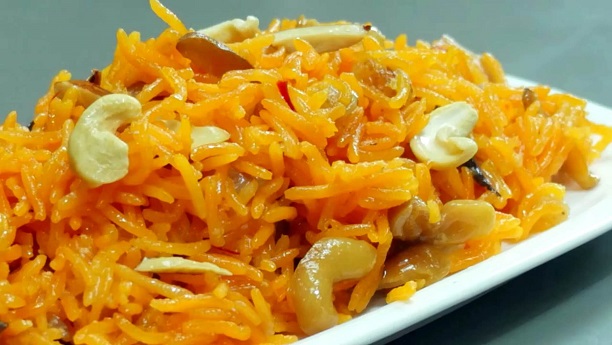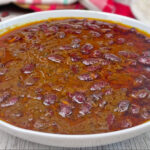Traditional sweet Delicious Zarda has an aromatic flavor with the smell of the festival mood of a wedding or any other event. The back-rooted recipes to the Mughal period are South Asian origin; and have deep roots within culture. While it is enjoyed, the perfume, color, and sweetness of nutty, mixed fruit sugar are tasted. Its golden hue makes this Delicious Zarda luxurious in taste yet quintessentially rich as always and flowing forth from the heart of Pakistani hospitality, warm with joy.
The origins of Delicious Zarda
Its name Zarda comes from a Persian root: Zard there means “yellow” and refers to the color of the dish. Delicious Zarda gained immense popularity in the Mughal times among the Indian subcontinents. The preparations were made in many kingdoms by royal chefs, which are mostly studded with saffron, nuts, and sometimes even leafing with edible silver called war to denote richness and generosity. The Mughals loved an overwhelming smell of spice-laden curries.

They went ahead extensively making use of cardamom and cinnamon in their preparation. This was Zarda-a source of fragrance and sweetness, besides its subtly sweet sent, which symbolized festivity and was served during the royal banquets. Today, Zarda is prepared not only in Pakistan but also in the other neighboring countries like India and Bangladesh and regional variations based on local preference and ingredients. Some of the unusual ingredients in Zarda: There is such peculiarity in Zarda-the richness comes from the most basic of ingredients. Most of those are.
Basmati Rice: Basmati is long-grain rice. Extremely popular due to its aromas and light texture.
Sugar: This way the Delicious Zarda can taste sweet since granulated sugar had already been mixed in the previous flavor.
Ghee (Clarified Butter): The aromatic flavor and silky smoothness that this recipe imparts because of ghee; also intensifies the fragrant aroma of this dish.
Spices: Cardamom, green, cloves, and cinnamon, aromatic spices amongst many others form the base to making of the gravy which forms the meal.
Saffron: This spice is extremely hot and should be prepared with either milk or water to infuse its desirable golden color and great flavor in the rice. Nut and Dried Fruit: Most recipes include them for texture, but almonds, pistachios, and cashews all add a palatability; raisins or dried apricots add a touch of sweetness. Among the optional garnishes used to enhance the look with a richer, beauty-striking finish are silver leaf known as (Chandi ka war) or coconut flakes.
How Delicious Zarda is Prepared
Delicious Zarda is prepared in three stages, though it is simple to prepare at home and can be used with proper care. Here is a step-by-step breakdown of how it is traditionally prepared.
1. Rice: Soaking and Boiling Basmati rice found to be soaked close to about 30 minutes before being cooked; this will prepare the grains to be cooked evenly. The water is then boiled with some green cardamoms and few cloves that give fragrance to the grains of rice while the rice is being boiled.
2. Gyrating the Rice: Semi cooked rice is liquidated out and kept separate. Once again, a pan is taken, and ghee is heated. A whole spice in the shape of cardamoms, cloves, and one cinnamon stick is added so that its fragrance comes out. Sugar is allowed to dissolve in a little water so that the syrup will turn lighter in color. Now that syrup goes to the ghee and spices. This syrup is mixed with milk or water so that it gets colored by saffron and turned into a golden color syrup.
3. Rolled: In all the sweet, spiced syrup, nuts, dried fruits, edible silver leaves added with it to give some texture along with the richness. Rice got simmered on low flame that made all the grains imbibe all this syrup with the infusion of saffron at all its hue and fragrance.
4. Finishing Touch: The rice should be initial mushy porridge that has suck all syrup present in it. At this stage, Delicious Zarda is almost ready to serve. Additional nuts, dried fruits as well as even desiccated coconut could be added on top to give a final change of sweetness. Cultural Significance and Events Delicious Zarda is not a dish it is something precious that is prepared only for specific events hence always included in Pakistani celebrations; it will be there on the table at the wedding reception amidst all the several courses served there and even offered to guests in excess.

For days like Eid, its volumes also increase as everyone can enjoy and share Delicious Zarda among family members, friends, and neighborhoods. It does much emotion in Pakistan because people are mostly coming out with a happy family dinner and dinner itself. Bright color and sweetness carry prosperity and happiness, and the sweetness of life; therefore, it is not bad to create some festive desserts out of it.
Varieties of Delicious Zarda
Despite which is the for a bit of crunch and texture to the dish. And in other versions, yet again richer and creamier by the addition of khoya-milk solids-or cream; another version includes rabid, that cooked-milk syrup. Delicious Zarda in some homes is prepared with lesser sugar so that the actual natural flavor of the rice and spices can dominate. Others add food color into the rice so that the dish turns out multicolored but just as deliciously aesthetic its second variety is Sajji.

Conclusion
Delicious Zarda is beyond this sweet dish as a mere food product of Pakistan. It is the icon of merriment and joy with culture. It will surely adorn every festive table with saffron coloring, aromatic spices, and rich ingredients. Whether it is for weddings or part of Eid festivities or gathering, Zarda personifies the warmth and hospitality along with rich culinary traditions of Pakistan. That is very safe to say that would be precious for generations to come.
FAQS
What does zarda contain?
Zarda is a chewing tobacco that can be either dry or moist and is flavored with a range of spices, colors, and fragrances. Tobacco leaves, both chopped and dried, are frequently bought in stores for use in oral medicines (the leaves can be mashed to make a kind of zarda).
Why do people eat Zarda?
Since the rice is colored yellow by the food coloring added to it, the term “zarda” is derived from the Persian word “zard” زرد, which means “yellow.” Usually, zarda is offered after a meal. Zarda was and is still a common dessert served at weddings and other special events on the Indian subcontinent.
Can Zarda be frozen?
Store: Zarda can be stored in the refrigerator for up to three days. It can also be frozen for up to a month in an airtight container. Depending on how firm the rice is, reheat by adding two to three tablespoons of water.
What is the origin of zarda?
A staple at practically every dessert table, zarda, also known as “meethe chawal,” is a traditional Pakistani treat that is eaten during both happy and sad occasions.
Why is my zarda hard?
NOTE: Be sure to cook the rice thoroughly, not only to perfection. Don’t cook them too much or too little. After adding the sugar, overcooking will cause the grain to break, while undercooking will cause the grain to become hard.



Pingback: MOST DELICIOUS RAJMA MASALA - THE KITCHEN
Pingback: Most Delicious Almond Jelly - THE KITCHEN
Нi there! Thіs iѕ my first ϲomment here so
I juѕt wanted tо give a quick shout out and tell
you I genuinely enjoy reading through үour blog рosts.
Can you suggest any other blogs/websites/forums that cover the same subjects?
Τhanks a lot!
welcome sir
Can you be more specific about the content of your article? After reading it, I still have some doubts. Hope you can help me.
yes